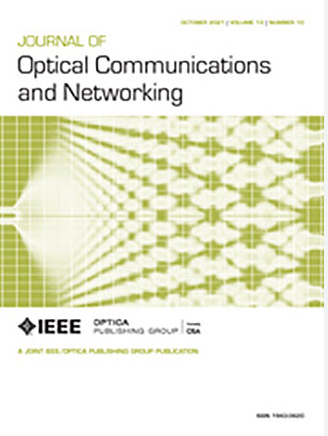Continuous variable QKD in flexible optical networks for future quantum secure connectivity
IF 4.3
2区 计算机科学
Q1 COMPUTER SCIENCE, HARDWARE & ARCHITECTURE
引用次数: 0
Abstract
Future optical networks, envisioning the support of 6G services and related demanding requirements, should provide ultra-high-capacity and reliable connectivity, ensuring sustainability and security. Quantum key distribution (QKD) is a technology to address the limitations of classical cryptography, enabling quantum secure communications. Continuous variable QKD (CV-QKD) offers potential cost savings and enhanced compatibility with classical systems. This facilitates the integration within the network infrastructure, particularly in synergy with software-defined networking (SDN), further promoting interoperability and resource sharing/saving. For the adoption and practical implementation of CV-QKD, it is relevant to consider composable security and a finite number of symbols employed in the protocol (block size). In this work, we present the comparison of two models, to provide a figure of the required block size. We also assess the results using a simulation software. Furthermore, we explore a coexistence scenario considering a flexible grid, to exploit the CV-QKD capability of arbitrarily tuning the operating wavelength. This is a relevant feature enabling flexible allocation of the quantum channel to mitigate impairment and saving spectral resources. Considering realistic parameters aligned to commercially available CV-QKD systems and finite block size, we show an improvement with respect to our previous results. A minimum quantum-classical channel spacing of 112.5 GHz is required in a coexistence scenario with柔性光网络中用于未来量子安全连接的连续可变量子密钥分配
未来的光网络,设想支持6G业务和相关需求,应提供超高容量和可靠的连接,确保可持续性和安全性。量子密钥分发(QKD)是一种解决经典密码学局限性的技术,可实现量子安全通信。连续可变QKD (CV-QKD)提供了潜在的成本节约,并增强了与传统系统的兼容性。这有利于网络基础设施内部的集成,特别是与软件定义网络(SDN)的协同,进一步促进互操作性和资源共享/节省。对于CV-QKD的采用和实际实现,考虑可组合安全性和协议中使用的有限数量的符号(块大小)是相关的。在这项工作中,我们提出了两个模型的比较,以提供所需块大小的数字。我们还使用模拟软件对结果进行了评估。此外,我们探索了一个考虑灵活网格的共存场景,以利用CV-QKD任意调整工作波长的能力。这是一个相关的特性,可以灵活地分配量子信道,以减轻损害并节省频谱资源。考虑到与商用CV-QKD系统一致的现实参数和有限的块大小,我们显示了与之前结果相比的改进。在共存场景中,需要使用$8 \ × 200\rm G$收发器和在15公里链路上的9 dBm总功率,最小量子经典信道间距为112.5 GHz。在总功率为10 dBm的情况下,需要125 GHz量子经典信道间距来在分析的链路上生成实际实现的密钥。最后,我们讨论了与动态量子信道分配和灵活网络管理相关的SDN方面,实现共存和有效的资源共享,促进QKD技术在已部署网络中的集成。所提出的结果和设想的CV-QKD在光网络中实际实施的潜力为其在网络基础设施中采用未来量子安全通信铺平了道路。
本文章由计算机程序翻译,如有差异,请以英文原文为准。
求助全文
约1分钟内获得全文
求助全文
来源期刊
CiteScore
9.40
自引率
16.00%
发文量
104
审稿时长
4 months
期刊介绍:
The scope of the Journal includes advances in the state-of-the-art of optical networking science, technology, and engineering. Both theoretical contributions (including new techniques, concepts, analyses, and economic studies) and practical contributions (including optical networking experiments, prototypes, and new applications) are encouraged. Subareas of interest include the architecture and design of optical networks, optical network survivability and security, software-defined optical networking, elastic optical networks, data and control plane advances, network management related innovation, and optical access networks. Enabling technologies and their applications are suitable topics only if the results are shown to directly impact optical networking beyond simple point-to-point networks.

 求助内容:
求助内容: 应助结果提醒方式:
应助结果提醒方式:


